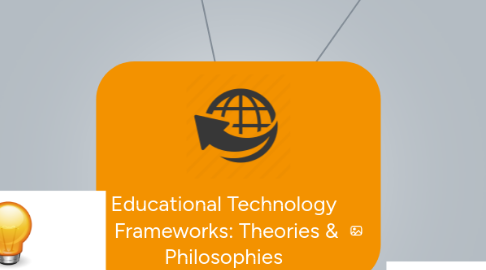
1. 21st Century Learning
1.1. Definition:
1.2. Founders:
1.2.1. Punya Mishra and Kristen Kereliuk
1.3. 21st Century Learning Model Framework
1.3.1. Foundational Knowledge
1.3.1.1. Content,
1.3.1.2. Information Literacy
1.3.1.3. Cross disciplinary Knowledge
1.3.2. Meta Knowledge
1.3.2.1. Problem Solving
1.3.2.2. Critical Thinking
1.3.2.3. Communication
1.3.2.4. Collaboration, Creativity
1.3.3. Humanistic Knowledge
1.3.3.1. Life Job Skills
1.3.3.2. Cultural Competence
1.3.3.3. Ethical and Emotional Awareness
2. Philosophy of Teachnology
2.1. Definition:
2.1.1. It is personal statement and belief system that a teacher holds in integrating technology in teaching
2.2. Founders
2.2.1. The Teacher
3. TPACK
3.1. Definition:
3.1.1. Technological Pedagogical Content Knowledge (TPACK) is a framework that identifies the knowledge teachers need to teach effectively with technology
3.2. Founder(s)
3.2.1. In 1986 Lee Shulman identified that a teacher had Pedagogical Knowledge and Content Knowledge
3.2.2. In 2006 Punya Mishra and Matthew Koelher formed TPACK
3.3. TPACK Model Framework:
3.3.1. Pedagogical Knowledge (PK)
3.3.2. Content Knowledge (CK)
3.3.3. Technological Knowledge (TK)
3.3.4. Pedagogical Content Knowledge (PCK)
3.3.5. Technological Pedagogical Knowledge (TPK)
3.3.6. Technological Content Knowledge (TCK)
3.3.7. Technological Pedagogical, and Content Knowledge (TPACK)
4. SAMR
4.1. Definition
4.1.1. A framework that focuses on the outcome of student achievement as a factor of different levels of technology integration in classrooms by teachers
4.2. Founder
4.2.1. Dr. Ruben Puentedura formed SAMR
4.3. SAMR Model Framework
4.3.1. Transformation:
4.3.1.1. Redefinition
4.3.1.2. Modification
4.3.2. Enhancement:
4.3.2.1. Augmentation
4.3.2.2. Substitution
